As loving pet parents, we often want to share our meals with our furry companions. However, what’s perfectly safe for us can be incredibly dangerous, even fatal, for dogs. Understanding what foods dogs can’t eat is crucial for their health and well-being. Every year, thousands of pets suffer from accidental poisonings due to ingesting toxic human foods. This guide aims to equip you with the knowledge to safeguard your canine friend from common household dangers.
The fundamental difference in canine digestion and metabolism compared to humans is the primary reason certain foods are toxic to dogs. Their bodies process specific compounds much differently, leading to rapid accumulation and potentially severe health consequences. For instance, theobromine and caffeine in chocolate are metabolized slowly by dogs, building up to toxic levels. Similarly, while we can digest cherries, the pits, stems, and leaves contain cyanide, which is harmful. Factors like a dog’s size, breed, and existing health conditions can also influence their susceptibility to food toxicity, highlighting the importance of consulting your veterinarian for any concerns.
Here’s an in-depth look at common human foods that are dangerous for dogs:
Common Foods Dogs Absolutely Cannot Eat
Many everyday foods pose significant risks to dogs. It’s essential to be aware of these to prevent accidental ingestion.
1. Alcohol
Alcohol is highly toxic to dogs, even in small amounts. Due to their smaller body size, the effects can be much more severe than in humans. Symptoms of alcohol poisoning include vomiting, respiratory distress, coma, and even death.
2. Apple, Apricot, Cherry, and Plum Seeds/Pits
While the flesh of apples is safe, the core and seeds contain cyanide. Similarly, the pits of apricots, cherries, peaches, and plums also contain cyanide. Ingesting these can lead to vomiting, irregular heartbeat, seizures, coma, and potentially death due to the disruption of oxygen transport to cells. The pits themselves can also cause digestive blockages.
3. Avocado
Avocados contain a toxin called persin, which can cause gastrointestinal upset in dogs. Furthermore, the large pit can pose a choking hazard and obstruct the digestive tract. While the risk of severe poisoning might be debated, it’s best to avoid this fruit altogether.
4. Broccoli
Broccoli contains isothiocyanates, which can be harmful to dogs in large quantities. While small amounts might be tolerated occasionally, it’s safer to avoid it, especially considering the availability of many other healthy dog-safe options. The stalks can also present an obstruction risk in the throat.
5. Caffeine and Coffee Grounds
Caffeine, found in coffee, tea, and some sodas, contains methylxanthines. These can lead to serious health issues such as vomiting, diarrhea, seizures, and abnormal heart rhythms. Even small amounts of coffee grounds or beans can be dangerous, causing a rapid heartbeat and potential complications.
6. Chicken and Turkey Skin, Ham, and Other Fatty Cuts of Meat
High-fat meats like ham, chicken skin, and turkey skin are detrimental to dogs. They can trigger acute pancreatitis, a painful and potentially life-threatening inflammation of the pancreas. Additionally, cooked poultry bones, including those from chicken and turkey, can splinter and cause internal injuries or blockages. Always remember what meat is not good for dogs to eat and opt for lean, cooked meats.
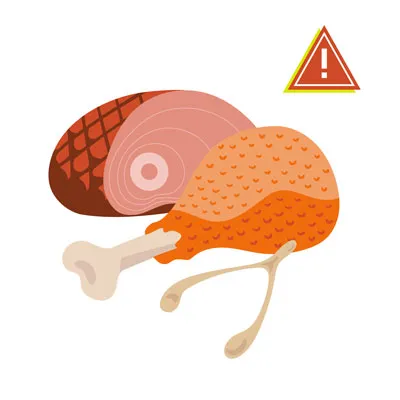 Fatty meat cuts are dangerous for dogs
Fatty meat cuts are dangerous for dogs
7. Chocolate
Chocolate is one of the most notorious toxins for dogs. It contains theobromine and caffeine, which dogs metabolize poorly. Dark chocolate and baker’s chocolate are particularly dangerous due to their higher theobromine content. Symptoms range from hyperactivity and vomiting to seizures and cardiac arrest. If your dog consumes any amount of chocolate, contact your veterinarian immediately. Chocolate is a significant concern, especially around holidays.
8. Grapes and Raisins
Grapes and raisins are highly toxic to dogs and can cause acute kidney failure. Even a small amount can be devastating. Symptoms include vomiting, diarrhea, loss of appetite, and changes in urination patterns. If you suspect your dog has ingested grapes or raisins, seek immediate veterinary care.
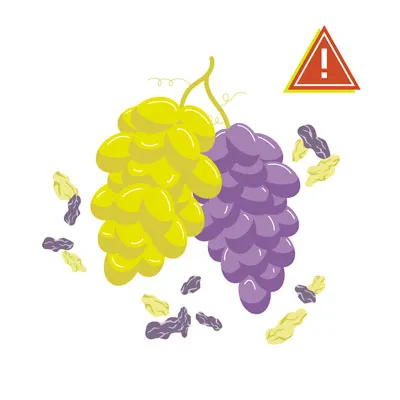 Grapes and raisins are highly toxic
Grapes and raisins are highly toxic
9. Macadamia Nuts, Almonds, and Pistachios
Macadamia nuts are particularly dangerous, causing weakness, vomiting, and tremors. While the exact toxic compound is unknown, as few as six nuts can cause severe poisoning in a small dog. Other nuts like almonds and pistachios can also be problematic due to their high fat content, potential for choking, and any added seasonings.
10. Milk and Dairy Products
Many dogs are lactose intolerant or allergic to dairy. While small amounts of cheese might be tolerated by some, milk and other dairy products can cause digestive upset, including gas and diarrhea. High-fat dairy like ice cream is also a poor choice.
11. Mushrooms
Wild mushrooms are highly toxic and can cause liver and kidney failure, as well as neurological issues. Even commercially grown mushrooms can pose a risk if not handled properly. It’s best to avoid feeding any type of mushroom to your dog.
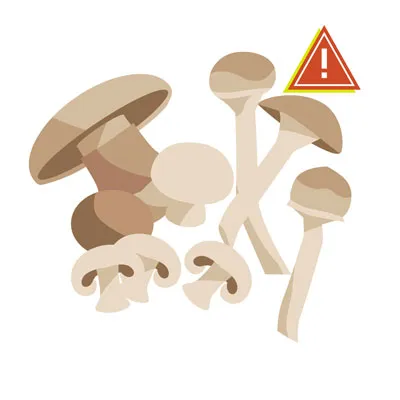 Mushrooms can be toxic to dogs
Mushrooms can be toxic to dogs
12. Nutmeg and Cinnamon
Nutmeg contains myristicin, which can cause hallucinations and severe vomiting in dogs, especially in larger doses. Cinnamon, while not as acutely toxic, can irritate a dog’s mouth and digestive tract, and in large amounts, it can lead to low blood sugar.
13. Onions, Garlic, Chives, and Leeks
These members of the allium family contain compounds that damage red blood cells, leading to anemia. Onion and garlic powders are common in processed foods, so always check ingredient labels. Certain breeds, like Akitas and Shiba Inus, are particularly sensitive.
14. Salt
Excessive salt intake can disrupt a dog’s fluid balance, leading to tremors, seizures, diarrhea, and even coma. Avoid giving your dog salty snacks like potato chips or anything with rock salt.
15. Spicy Food
Spicy foods can cause significant gastrointestinal distress in dogs, leading to vomiting, diarrhea, and painful stomach ulcers.
16. Sugar-Free Gum and Candy (Xylitol)
Xylitol is a sugar substitute found in many sugar-free products, including gum, candy, and baked goods. It is extremely toxic to dogs, causing a rapid drop in blood sugar and potentially leading to liver failure and seizures. Even small amounts can be fatal.
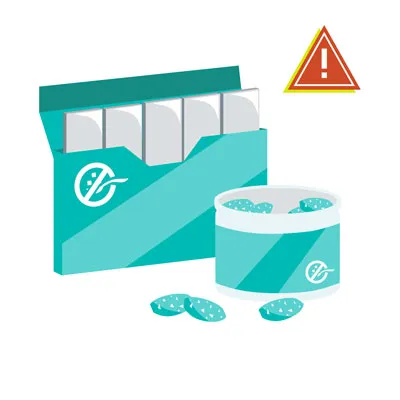 Xylitol is extremely dangerous
Xylitol is extremely dangerous
17. Tomatoes and Raw Potatoes
While ripe tomatoes are generally safe in moderation, the green parts of the tomato plant and unripe tomatoes contain solanine, which is toxic. Raw potatoes also contain solanine. Cooked potatoes without seasonings are generally safe.
18. Tobacco
Nicotine in tobacco is poisonous to dogs and can cause vomiting, diarrhea, rapid breathing, tremors, and seizures. In severe cases, it can lead to coma and death.
19. Yeast and Raw Dough
Raw dough containing yeast can expand in a dog’s stomach, causing severe pain and potentially life-threatening torsion or rupture. Furthermore, the yeast fermentation produces alcohol, leading to alcohol poisoning.
20. Raw Meat
Feeding raw meat to dogs carries a risk of Salmonella and E. coli contamination, which can affect both the dog and the household. Raw meat bones can also splinter and cause internal injuries.
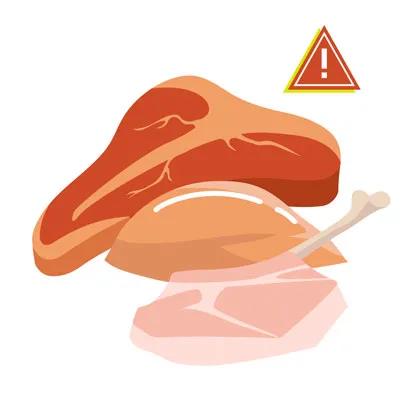 Raw meat can harbor harmful bacteria
Raw meat can harbor harmful bacteria
21. Rhubarb
The leaves of the rhubarb plant contain soluble calcium oxalate crystals, which can bind with calcium in the body, leading to a dangerous drop in levels and potential kidney failure.
22. Star Fruit
Similar to rhubarb, star fruit also contains soluble calcium oxalate crystals and should be avoided.
23. Flavored Water and Seltzer Water
While plain water is essential, flavored and carbonated waters can contain artificial sweeteners, sugars, or salts that are harmful to dogs. Stick to fresh, clean water.
What Dogs Are Most at Risk?
While all dogs should be protected from toxic foods, certain groups are more vulnerable:
- Small Breeds: Their lower body weight means even small amounts of toxins can have a significant impact.
- Puppies: Their developing digestive and immune systems are more susceptible to harmful substances.
- Elderly Dogs: Older dogs may have underlying health conditions that make them more prone to complications from ingesting toxic foods.
- Dogs with Pre-existing Conditions: Chronic health issues can make a dog more susceptible to severe reactions to toxins.
How to Prevent Your Dog from Eating Toxic Foods
Prevention is key to keeping your dog safe. Here’s how to minimize the risk:
- Secure Storage: Keep all toxic foods and ingredients stored securely out of your dog’s reach, in high cabinets or sealed containers.
- No Table Scraps: Strictly avoid feeding your dog from your plate or during meal preparation. This reinforces that they should only eat their own designated food and treats.
- Educate Everyone: Ensure all family members, children, and guests understand which foods are off-limits for your dog and the dangers involved.
- Holiday Vigilance: During busy holidays, when food is abundant and attention may be divided, be extra cautious. Ensure countertops are clear and dogs are supervised. Always have the contact information for your veterinarian and an emergency pet poison control center readily available.
What to Do if Your Dog Eats Something Toxic
If you suspect your dog has ingested a toxic food, act immediately:
- Contact Professionals: Call your veterinarian or a pet poison control hotline right away. Prompt treatment significantly increases the chances of a positive outcome.
- Provide Information: Be ready to provide details about the ingested food, the estimated amount consumed, and the time of ingestion.
- Avoid Home Remedies: Do not attempt to induce vomiting or administer home remedies unless specifically instructed by a veterinarian, as some interventions can be harmful depending on the substance ingested.
Keeping your canine companion safe from harmful human foods requires constant vigilance and awareness. By understanding what foods dogs can’t eat, you can create a healthier and safer environment for your beloved pet. When in doubt, always consult your veterinarian. Exploring what ingredients are not good for dogs and understanding what can’t you feed your dog are essential parts of responsible pet ownership.
